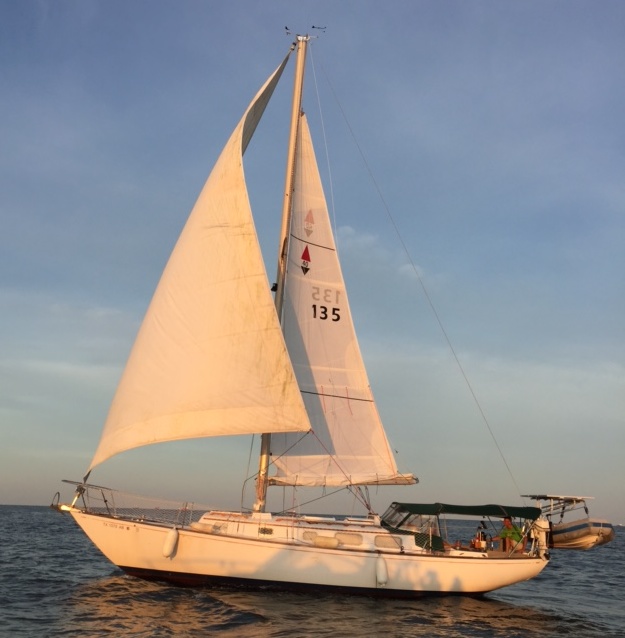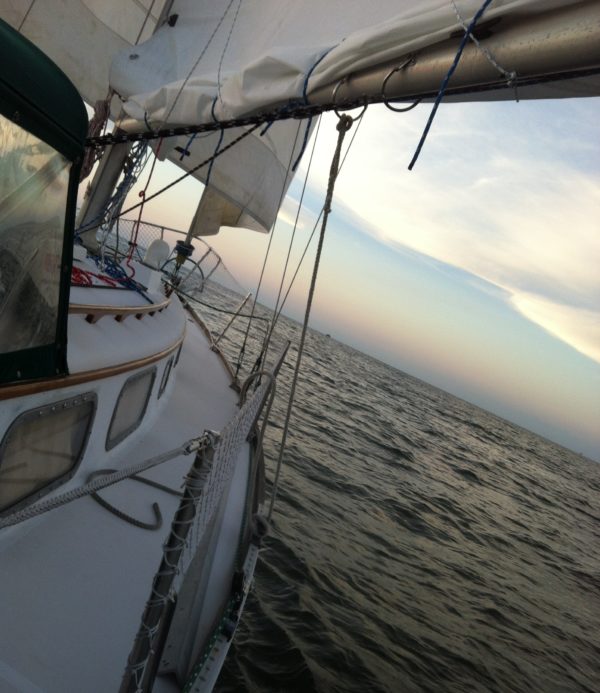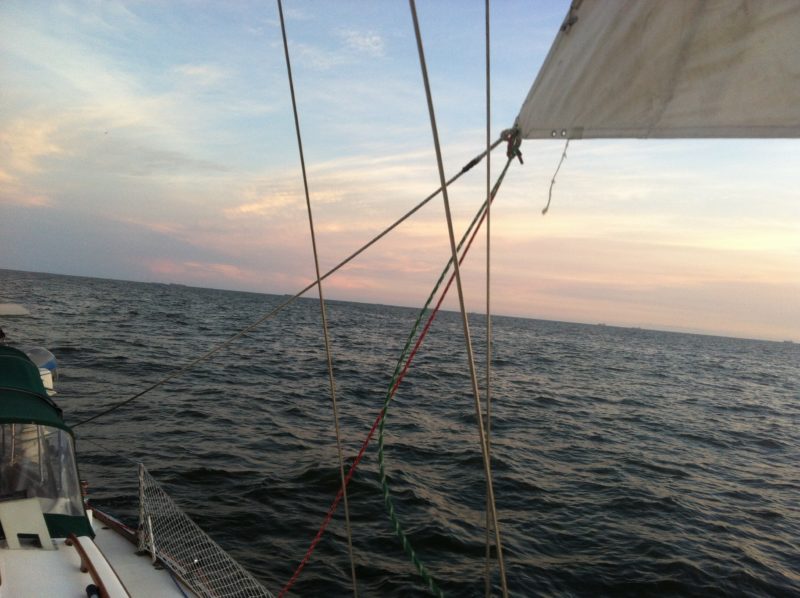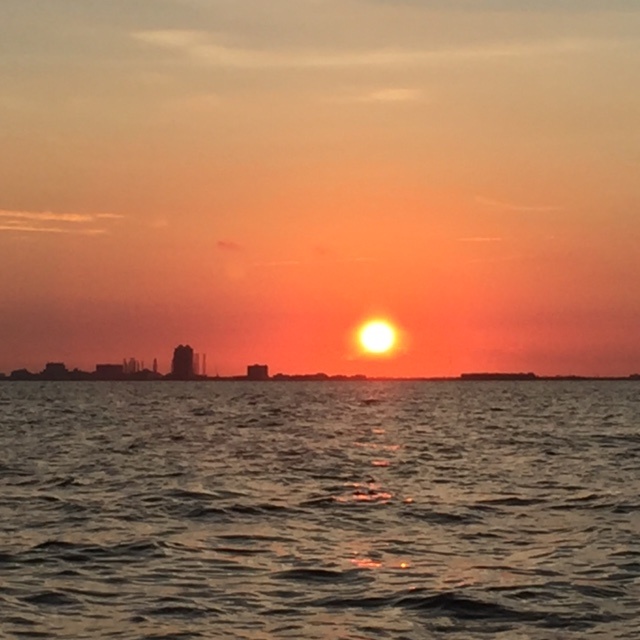We went for our first sail in the Gulf of Mexico this past weekend.
The marina channel to the ICW is definitely shallow and we ran into mud twice getting into the ICW. Fortunately, it’s very soft mud and going slow helps prevent us from wedging ourselves into any bank that we encounter. We just reverse back into the “deeper” water and then take a different route. It’s becoming standard operating procedure.
It’s 4 hours of motoring at 4.5 knots to get from the marina to the end of the south jetty at Galveston. Much better than the 10 to 11 hours from Seabrook.
We also learned that not all bridges that require contact with a bridge operator are named properly, or named at all, on the Navionics charts. Calling the Galveston Channel Bridge operator on 16 yields you nothing even though the chart says it’s the Galveston Channel; no mention of the bridge name. We kept getting the Galveston Causeway Railroad bridge operator and we finally said that we were trying to reach the small bridge into the Galveston Channel. At that point the X bridge operator came on and we were politely informed that, for future reference, it’s called the Pelican Island bridge. Oh…
We made it to the end of the jetty without incident, raised the sails, killed the engine, and steered a course S/SE. It’s so much nicer being able to set the sails and just sail out in the Gulf. In the Bay we had to worry about uncharted pipes and pilings, shallow water, other small vessels, obnoxious speed boaters, The Kemah Beast, and the ship channel traffic. At 4 NM from the shore, there’s really nothing to worry about. Just set the sails and sail. We don’t have a self steering system yet, but I was able to get everything “balanced” and Emet would track and hold her course for 4 to 5 minutes before I had to make a small correction.
To avoid potentially running through some shipping traffic we adjusted course SW and ran parallel with the shore for about 2 NM, then resumed our S/SE heading for about 5 NM. Nothing like being able to set sail and steer a course for mile after mile after mile knowing that it’s clear. The water was calm, the winds light, the sun bright. This is what cruising is supposed to be.
We turned around and headed back with the plan of anchoring out overnight. We wanted to be able to drop anchor before it got too late.
On the sail back we had a broad reach on a port tack. It was very light air. We don’t have a boom preventer set up or a whisker pole. To keep our boom from flogging about I tied a line from one of the boom bails to the mid-ship cleat and cinched it tight. This worked very well.
In that same pic you can see that our genoa is also luffing and flogging about. I was really thinking how nice a whisker pole would be. I then got the idea that I might be able to keep the genoa from luffing as much by tying a line to the clew and running it to the port stern cleat.
Not as effective as a whisker pole, but it certainly helped stabilize the sail. It prevented it from luffing forward, which helped it maintain its shape and more easily recover and fill in the light air.
So, we sailed on to our anchor spot. We arrived around 9:00 PM, dropped the Mantus anchor, and let out about 30 to 40 feet of our Maggi chain. I backed down on it hard and Emet began swinging on the anchor. It seemed that the anchor was dug in good. I paid out the remaining chain and about 50 feet of our 300 foot 3/4″ nylon line. We were now resting on 150 feet of anchor rode in about 15 feet of water.
We killed the engine and fixed dinner. It was going to be a peaceful night. Or so I thought.
I was sleeping in the cockpit on the starboard seat because there was a nice breeze and it was a little cooler up there. At about 1 AM I was literally thrown awake. I woke up flying off the cockpit seat cushion, looking down at the water, and grabbed the steering pedestal to keep from crashing into it. I called down to Jodi in the middle of all the racket that was crashing and banging inside:
“Are you OK?”
She said, “Yes.”
“Wow, that was a pretty big one.”
“Yeah, you slept through the other ones. That was the biggest one, though.”
“The other ones . . .?”
“It’s been like that all night.”
And that was our first rolly anchorage. It was pretty rolly all night and there was quite a current. I could hear it clearly rushing past the boat and could see bubbles and light foam created as Emet’s bow split the surging water. I watched for a while and then went back to sleep. Every now and then I was awakened by rolling that was a little more intense than the rest. Occasionally, I would check our position to make sure we weren’t drifting. We weren’t. The anchor was holding steady.
We woke up around 7 AM. Position check showed that we hadn’t moved, but we had swung around. Coffee and ship watching for an hour or so then the anchor came up and we started motoring back. Completely uneventful. We did run into another mud bank right off the ICW into the marina channel, but some folks in a power boat saw us and pulled us free. As they were pulling us off, I watched the depth sounder and I “think” I know where to go to avoid the mud. As we reentered the marina channel on this “new” path, we didn’t run into anything.
Looking forward to the next Gulf sail.





[…] would be nice to have some type of self-steering system on Emet. When we went for our first gulf sail, it became immediately apparent how tedious it is sitting for hours upon hours at the wheel. Even […]